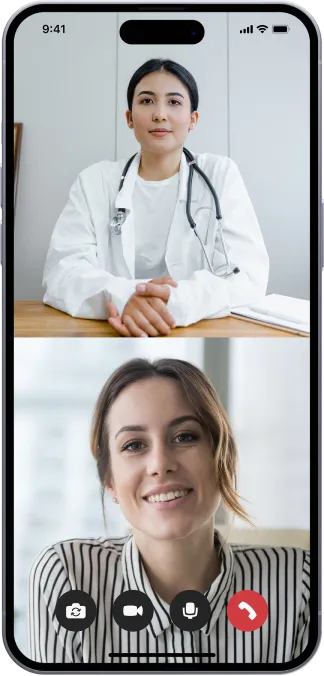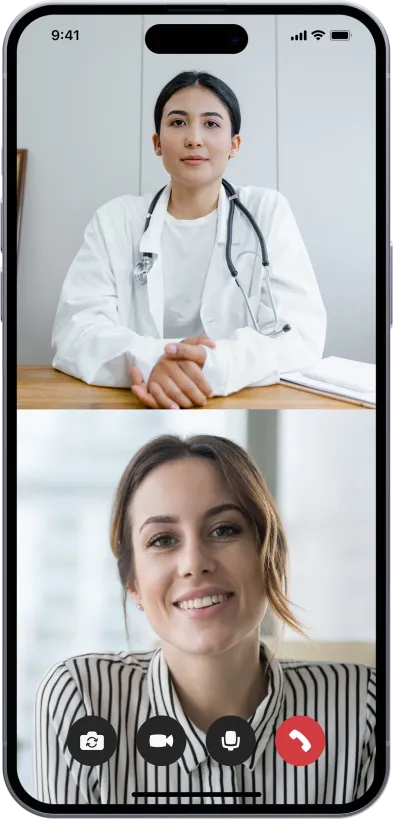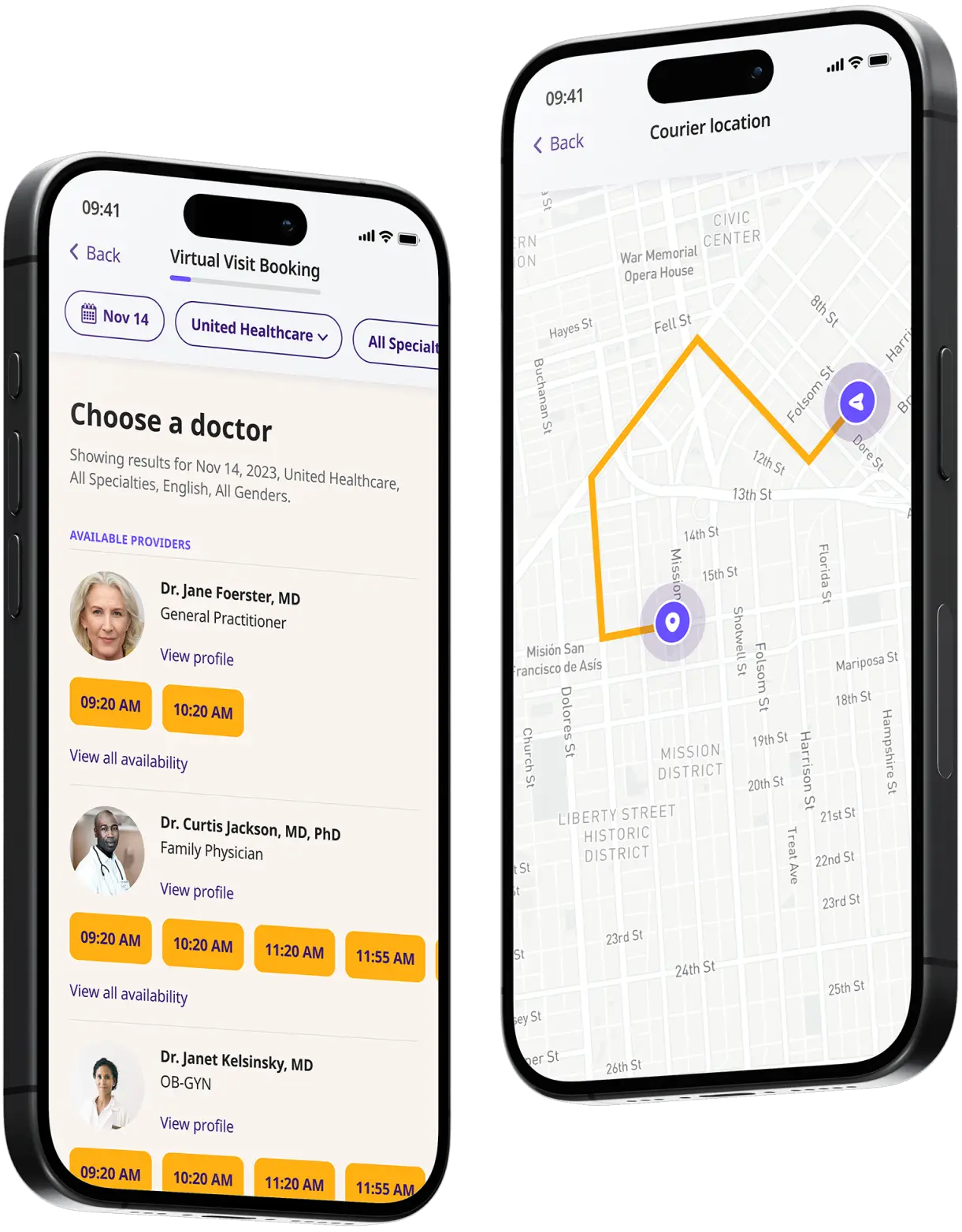Rosacea Treatment Online
Manage redness and flare-ups from rosacea with ease. See an online doctor for tailored care and treatment options.


Available in 50 states. Insurance accepted.
Fast
virtual visits
24/7 care
assistants
Prescriptions
as needed

24/7 Personal Care
Consult with a physician in 15 minutes, refill an Rx or chat with our care assistants.

Affordable & Convenient
See your cost upfront and get treatment for hundreds of different conditions.

Insurance Accepted
We accept most major insurance plans, making healthcare easy and affordable.
See If Delivery Is Available Near You
Delivery Not Available
Enter your ZIP code to check if prescription delivery is available in your area and how soon your meds could arrive.
How to get started
Choose your doctor, start a virtual visit, and have your prescriptions sent to your preferred pharmacy for pickup — all in just a few easy steps.
Choose a doctor
Choose a physician by availability, specialty, ratings, and more.

Start your video visit
Connect with a doctor in minutes on a secure video call.

Get your prescription
Pick up your meds or have them delivered in as little as an hour.

Available in 50 states. Insurance accepted.
One-Time
Physician Visit
One-time visit with a physician for diagnosis, treatment, Rx, labs, referrals, and doctor’s notes.
Accepted Insurances
See why people turn to DrHouse...
As seen in

Rosacea Treatment Online
What is rosacea?
Rosacea is a chronic skin condition that predominantly affects the face, presenting as redness, visible blood vessels, and sometimes small, red, pus-filled bumps.
These symptoms can flare up for weeks to months before diminishing again. While rosacea is most commonly seen in middle-aged women with fair skin, it can affect anyone at any age.
This condition is often mistaken for other skin disorders such as acne or an allergic reaction. However, rosacea is distinct due to its characteristic patterns and triggers.
Unlike acne, it primarily causes redness and flushing across the cheeks, nose, chin, and forehead. Over time, these symptoms can become persistent, and in severe cases, the skin can thicken and enlarge, particularly around the nose (a condition known as rhinophyma).
What causes rosacea?
The precise cause of rosacea remains unclear and is considered to be multifactorial, involving a combination of genetic, environmental, and vascular components.
Researchers continue to explore various theories to better understand the underlying mechanisms that contribute to the development of this complex skin condition.
Here are some of the most widely discussed factors:
- Genetic predisposition: There is strong evidence suggesting that rosacea may be hereditary. Many individuals with rosacea have a family history of the condition or related symptoms, indicating that genetic factors likely play a significant role.
- Vascular irregularities: Rosacea is characterized by redness and visible blood vessels in the face, which suggests abnormalities in blood vessel function. Some theories propose that increased reactivity of blood vessels to certain stimuli may lead to the dilation that causes the characteristic redness of rosacea.
- Inflammatory responses: Abnormal immune or inflammatory responses are also believed to contribute to rosacea. This might include an overreaction of the skin’s immune system to certain bacteria or Demodex mites (tiny mites that live on the skin). The presence of these mites in higher numbers on the skin of rosacea patients suggests they could be involved in triggering inflammation.
- Microbial factors: The role of microbes in rosacea is supported by the observation that antibiotics and anti-inflammatory treatments can reduce rosacea symptoms. This implies that bacteria, particularly those associated with the skin and gut, might influence the development or exacerbation of rosacea.
- Environmental triggers: Various environmental factors can trigger or worsen rosacea symptoms. These include exposure to sunlight, hot or cold weather, wind, stress, strenuous exercise, hot baths, and consumption of spicy foods or alcohol. Each person may have different triggers, and part of managing rosacea involves identifying and avoiding these triggers.
- Skin barrier dysfunction: There is increasing evidence that a compromised skin barrier could contribute to the onset and progression of rosacea. A weakened barrier makes the skin more susceptible to irritants and allergens, which can exacerbate symptoms and lead to increased sensitivity.
Rosacea symptoms
Rosacea is a condition marked by a range of symptoms, primarily affecting the facial skin. The symptoms can vary widely among individuals and can fluctuate in severity over time, often characterized by periods of flare-ups followed by times of remission. Here are the primary symptoms associated with this condition:
- Facial redness: Persistent redness in the central part of the face, particularly on the cheeks, nose, chin, and forehead, is one of the most common signs of rosacea. This redness can resemble a blush or sunburn that does not go away.
- Visible blood vessels: Small blood vessels on the nose and cheeks often swell and become visible, known as telangiectasia.
- Swollen bumps: Many people with rosacea also develop small, red, pus-filled bumps or pimples on their face. These may resemble acne, but the skin is typically not greasy, unlike acne.
- Eye problems: Ocular rosacea is a condition where the eye symptoms precede the skin symptoms. It can include red, irritated, and swollen eyes and eyelids, a condition known as conjunctivitis. Patients may also experience the sensation of a foreign body in the eye.
- Dry, rough skin: The skin in the affected area may feel dry and rough. In more advanced cases, excess tissue might build up, especially around the nose, making it appear bulbous (rhinophyma).
- Burning or stinging: Those with rosacea often report feelings of burning or stinging on their facial skin, especially when they apply certain skincare products or are exposed to wind and sun.
- Flushing: Many individuals with rosacea experience episodes of flushing, where the skin turns red for a short duration due to various triggers such as emotional stress, hot weather, spicy foods, or alcoholic beverages.
- Skin thickening: Over time, the skin may thicken and develop a rough texture, especially common around the nose. This can lead to visible changes in the shape of the nose and is more frequently observed in men.
The presence and intensity of these symptoms can vary widely from person to person and may evolve in stages. Not all individuals will experience all symptoms, and the severity can range from mild to severe.
Triggers
Rosacea triggers are specific conditions or factors that can cause a flare-up of symptoms, leading to increased redness, inflammation, and discomfort.
Here are some common triggers that individuals with rosacea may encounter:
- Sun exposure: Ultraviolet (UV) light from the sun is one of the most common triggers for rosacea flare-ups. Sun exposure can cause dilation of blood vessels, leading to increased redness and inflammation.
- Hot and cold weather: Extremes in weather, including strong winds, can exacerbate rosacea symptoms. Cold weather can lead to dryness and irritation, while hot weather can increase flushing and redness.
- Stress and emotions: Emotional stress is a significant trigger for many people with rosacea. Stress can cause flushing and an increase in skin sensitivity, worsening the symptoms.
- Hot beverages and spicy foods: Consuming hot drinks like coffee or tea and spicy foods are well-known triggers that can cause temporary flushing and intensify rosacea symptoms.
- Alcoholic beverages: Alcohol, especially red wine, can cause vasodilation and flushing in many individuals with rosacea.
- Exercise: While physical activity is important for overall health, intense exercise can provoke rosacea symptoms due to increased heat and sweat production.
- Cosmetics and skin care products: Certain skincare products, cosmetics, and topical irritants can trigger rosacea. Alcohol, witch hazel, fragrance, menthol, peppermint, and eucalyptus oil are common ingredients that might irritate sensitive skin.
- Medications: Some medications, such as vasodilators and topical steroids, can exacerbate rosacea symptoms by increasing blood flow to the surface of the skin.
- Dietary factors: Beyond spicy foods, some individuals might find that specific foods such as dairy products or certain fruits and vegetables can trigger their symptoms.
- Environmental factors: Environmental irritants like indoor heat, humidity, or pollution can also trigger rosacea flare-ups.
How is rosacea treated?
Rosacea is a chronic skin condition with no definitive cure, but there are various treatments available that can help manage symptoms and control flare-ups. Treatment strategies are tailored to the severity and type of rosacea, focusing on reducing visible symptoms and preventing the condition from worsening. Here’s an overview of the current treatment options for rosacea:
- Topical treatments: These are often the first line of defense in managing rosacea and include creams, gels, and lotions applied directly to the skin. Medications such as metronidazole, azelaic acid, and ivermectin are commonly prescribed to reduce inflammation and redness. These treatments can help control the bumps, pimples, and some of the redness associated with mild to moderate rosacea.
- Oral medications: For more severe cases, especially those involving ocular rosacea or when topical treatments are insufficient, oral antibiotics like doxycycline or minocycline may be used. These antibiotics help reduce inflammation and are typically used in short courses to avoid antibiotic resistance. In cases of severe phymatous rosacea, isotretinoin, a powerful drug used in the treatment of severe acne, may be considered, albeit with strict monitoring due to its potential side effects.
- Laser and light therapy: Treatments such as laser therapy and intense pulsed light (IPL) can be effective in reducing the visibility of blood vessels (telangiectasia) and persistent redness. These therapies work by targeting and collapsing the blood vessels under the skin without damaging the surrounding tissue. Multiple sessions are usually required, and maintenance treatments may be needed to sustain results.
- Lifestyle changes: Since rosacea can be triggered by environmental factors and lifestyle choices, patients are advised to identify and avoid their specific triggers. This might include wearing sunscreen daily, protecting the face from extreme temperatures, managing stress, modifying diets (avoiding spicy foods and alcohol), and selecting suitable skincare products that do not irritate the skin.
- Skincare products: Using gentle skincare products is crucial in managing rosacea. Non-abrasive cleansers, fragrance-free moisturizers, and products formulated for sensitive skin can help maintain the integrity of the skin barrier and reduce symptoms.
- Ocular rosacea treatment: When rosacea affects the eyes, it is essential to practice good eyelid hygiene. Washing the eyelids gently with baby shampoo or other non-irritating cleaners can help. In some cases, doctors may prescribe antibiotic ointments or drops to reduce inflammation.
- Dietary considerations: Although specific dietary changes can help manage rosacea, it’s generally beneficial to maintain a balanced diet rich in anti-inflammatory foods like omega-3 fatty acids, nuts, seeds, and plenty of fruits and vegetables. Patients are also advised to keep a food diary to help identify any food-related triggers.
Rosacea Medication
Effective management of rosacea often involves the use of various medications, each tailored to address different symptoms and stages of the condition.
These medications can reduce inflammation, decrease flare-ups, and help manage the physical manifestations of rosacea. Here is a detailed overview of the primary types of medications used to treat rosacea:
- Topical medications:
- Metronidazole: Available in gel, cream, or lotion form, this antibiotic is used to reduce inflammation and redness. It is suitable for long-term treatment as it is generally well tolerated.
- Azelaic Acid: This medication helps by clearing up bumps, lesions, and swelling due to its anti-inflammatory and antimicrobial properties. It is also effective in reducing skin redness and rosacea-related pigmentation issues.
- Ivermectin: A cream used to treat inflammatory lesions of rosacea, ivermectin has both anti-inflammatory and anti-parasitic properties, helping to reduce redness and swelling.
- Brimonidine: Specifically targeting facial redness, this topical gel works by constricting blood vessels to reduce the appearance of redness. Its effects are temporary, often used for quick relief.
- Oral medications:
- Tetracyclines (Doxycycline, Minocycline): These are the most commonly prescribed antibiotics for moderate to severe rosacea, particularly effective in reducing inflammation and redness. They are typically used in low doses that do not have antibiotic effects but are anti-inflammatory.
- Isotretinoin: For severe cases, particularly those resistant to other treatments, this potent medication can be used. It is primarily known for treating severe acne but is occasionally prescribed for severe rosacea, especially where excess tissue growth is involved.
- Vasoconstrictors:
- Oxymetazoline Hydrochloride: Available as a topical cream, it helps reduce redness by constricting blood vessels near the skin’s surface. It’s indicated for persistent facial redness associated with rosacea.
- Ocular rosacea treatment:
- Oral Antibiotics: Doxycycline can also be prescribed for ocular rosacea to reduce inflammation of the eyelids and dry eyes.
- Steroid Eye Drops: These can be used temporarily to reduce eye inflammation but must be used with caution under direct medical supervision to avoid potential side effects.
How can DrHouse help you?
At DrHouse, we understand the physical and emotional toll that rosacea can take on individuals. That’s why our team of experienced online doctors is dedicated to providing personalized treatment plans tailored to each patient’s unique needs and preferences.
Through a combination of medical expertise and cutting-edge technology, we strive to help patients effectively manage their rosacea symptoms and improve their overall quality of life.
Our online platform offers convenient and confidential consultations, allowing patients to connect with a licensed physician from the comfort of their home. Our doctors can prescribe appropriate medications, provide recommendations for lifestyle changes and skincare products, and offer ongoing support to help patients manage their condition effectively.
If you are struggling with rosacea or suspect that you may have this condition, don’t hesitate to seek professional help. With DrHouse, managing your rosacea has never been easier. Schedule an appointment today and take the first step towards healthier skin!
Related services
Explore more of our services tailored to your needs and discover additional ways we can support your healthcare needs.
Frequently asked questions




